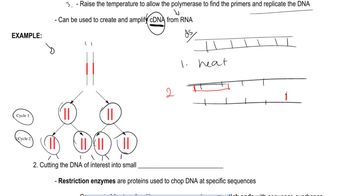Table of contents
- 1. Introduction to Genetics51m
- 2. Mendel's Laws of Inheritance3h 37m
- 3. Extensions to Mendelian Inheritance2h 41m
- 4. Genetic Mapping and Linkage2h 28m
- 5. Genetics of Bacteria and Viruses1h 21m
- 6. Chromosomal Variation1h 48m
- 7. DNA and Chromosome Structure56m
- 8. DNA Replication1h 10m
- 9. Mitosis and Meiosis1h 34m
- 10. Transcription1h 0m
- 11. Translation58m
- 12. Gene Regulation in Prokaryotes1h 19m
- 13. Gene Regulation in Eukaryotes44m
- 14. Genetic Control of Development44m
- 15. Genomes and Genomics1h 50m
- 16. Transposable Elements47m
- 17. Mutation, Repair, and Recombination1h 6m
- 18. Molecular Genetic Tools19m
- 19. Cancer Genetics29m
- 20. Quantitative Genetics1h 26m
- 21. Population Genetics50m
- 22. Evolutionary Genetics29m
18. Molecular Genetic Tools
Genetic Cloning
Problem 29a
Textbook Question
Textbook QuestionVitamin E is the name for a set of chemically related tocopherols, which are lipid-soluble compounds with antioxidant properties. Such antioxidants protect cells against the effects of free radicals created as by-products of energy metabolism in the mitochondrion. Different tocopherols have different biological activities due to differences in their retention by binding to gut proteins during digestion. The one retained at the highest level is α-tocopherol, whereas γ-tocopherol is retained at less than 10% of that efficiency. In Arabidopsis, α-tocopherol is the most abundant tocopherol in leaves, whereas γ-tocopherol is the most abundant in seeds. An enzyme encoded by the VTE4 gene can convert γ-tocopherol to α-tocopherol. How would you create an Arabidopsis plant that produces high levels of α-tocopherol in the seeds?
 Verified Solution
Verified SolutionThis video solution was recommended by our tutors as helpful for the problem above
Video duration:
3mPlay a video:
243
views
Was this helpful?
Related Videos
Related Practice

